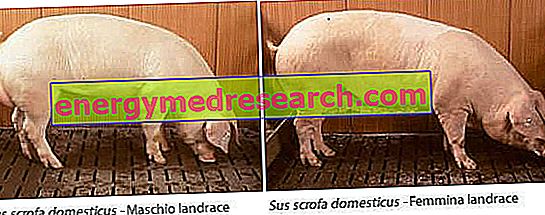Synonyms of generic pig : pig, pig;
synonym of male pig : boar;
synonyms of female pig : sow;
synonyms of small pig : piglet, verretto, scrofetta.
Generality
The term "pig" means a farm animal intended for slaughter. The pig belongs to the class of Mammalia (mammals), family Suidae, Genus Sus, species sow ; the subspecies mostly reproduced in captivity corresponds to the domesticus ( Sus scrofa domesticus ). The "recognized" Italian pig breeds are: Calabrese pork, Casertano pork, Cinta Senese pork, Moro Romagna pork, Sicilian black pig and Sardinian pig.
NB . The European wild boar, which for its part is totally wild, belongs to the same species as the pig; the native wild boar breeds are the majori ( Sus scrofa majori ) and the meridionalis ( Sus scrofa meridionalis ).

The pig looks like an imposing animal, with a massive, stocky body, covered with hair (bristles) and with a small curled tail. Suffice it to say that the fattening pig exceeds 150kg, has a short neck and equally short and thin legs that end with 4 nailed toes. The snout is typically maialesco, with a disc-like nose, flattened (griffin) and totally hairless; the pig's eyes are very small while the ears appear large and falling forward. The pig does not have a good view but on the other hand it uses a superfine hearing and smell; the mouth is powerful and has very sharp incisors, sharp canines and particularly robust molars. The pig is omnivorous and is able to find bulbs, tubers and truffles from under the ground; not surprisingly, this animal (if trained) is successfully used in truffle hunting.
The pig loves (and needs) to roll in the mud with which it protects itself from parasites.
The pig reproduces twice a year, respectively in spring and autumn with a gestation period of 15 weeks leading to the birth of 4-10 piglets (piglets), which wean at 3 months with a weight of about 25kg.
The pig has always been an animal bred, both on an industrial level, and on a household or farm level. Obviously it requires the presence of a closed and covered pigsty, equipped with containment troughs for feeding and drinking; there must also be a large open space where the pig can root and bathe in mud. From the third month of life up to a weight of about 120kg, the pig is fed mainly with flour, cereals, chopped corn, potatoes, fodder and kitchen scraps.
NB . In the Po valley, the peasants used to let the pigs graze in the already "exploited" orchard, allowing the animals to feed on apples and pears that had fallen from the plants.
The pig is a gregarious animal and has a remarkable social structure (justified also by the excellent intelligence that the animal demonstrates in its activities); the pig has a typically complex communication system structured both by various behaviors and by a wide range of vocalizations.
Currently, the most bred breed is the Landrace ; this pig has an elongated shape, a rosy coat and transparent bristles; it is of English origin, has a high fertility and a remarkable resistance to diseases. The pig is used:
- The meats, fresh and preserved
- The fifth quarter (offal, fat, blood, etc.) fresh and preserved (cracklings, coppa di testa, liver sausages, etc.)
- Bones, for the home production of soap or glue
- Leather, for the production of gloves, shoes, suitcases and belts
- The bristles, for the production of brushes.
From the food point of view, the pig can be classified into two types (distinguished by breeding, weight and size): the light pig (which is slightly more than a quintal) and the heavy pig (which exceeds the quintal and a half, and constitutes a 'EXLUSIVE Italian).
Image of the pig in history
The decline of the pig
Despite the analogies and negative meanings attributed to him today, the pig has represented (in almost all cultures) a decisive element for the survival of man. The first graffiti in pig farms date back as far as 40, 000 BC
In fact, Greek mythology mentions that Maia (from May, as well as pig) was one of the seven Pleiades or minor deities, while the Romans often offered a sacrifice of pigs (and other animals) to the gods, hoping for their benevolence. Unfortunately, at the same time as the republican virtues of Rome faded away, the advent of professional armies and the slavery of working in the countryside, the pig lost all prestige and, although the Christian religion redeemed its Jewish and Muslim taboo, associated it with a meaning anyway. negative: lust. Among other things, the most prepared readers on the subject will already be aware of the Jerash episode; according to the sacred scriptures (and even before the advent of the Mosaic and Mohammedan laws), in Jordan (at Jerash), Jesus exorcised some demons that infested the bodies of Christians and confined them inside some grazing pigs (which ended soon suicide in the lake below).



